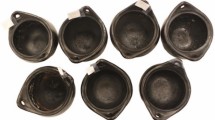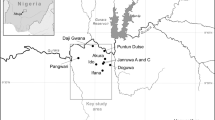Foaming chocolate prepared in spouted vessels made a delectable Preclassic drink.
Abstract
The Maya archaeological site at Colha in northern Belize, Central America, has yielded several spouted ceramic vessels that contain residues from the preparation of food and beverages. Here we analyse dry residue samples by using high-performance liquid chromatography coupled to atmospheric-pressure chemical-ionization mass spectrometry, and show that chocolate (Theobroma cacao) was consumed by the Preclassic Maya as early as 600 bc, pushing back the earliest chemical evidence of cacao use by some 1,000 years. Our application of this new and highly sensitive analytical technique could be extended to the identification of other ancient foods and beverages.


Similar content being viewed by others
References
Hester, T. R. & Shafer, H. J. in Archaeological Views from the Countryside: Village Communities in Early Complex Societies (eds Schwartz, G. M. & Falconer, S. E.) 48–63 (Smithsonian Institution, Washington DC, 1994).
Valdez, F. Jr The Prehistoric Ceramics of Colha, Northern Belize. Thesis, Harvard Univ. (1987).
Powis, T. G. & Hurst, W. J. Proc. 66th Annu. Meeting Soc. Am. Archaeol. (New Orleans, 2001).
Coe, S. D. & Coe, M. D. The True History of Chocolate (Thames & Hudson, London, 1996).
Tozzer, A. M. Landa's Relación de Las Cosas de Yucatán (Kraus Reprint, New York, 1941).
Potter, D. R. in The Colha Project, Second Season, 1980 Interim Report (eds Hester, T. R., Eaton, J. D. & Shafer, H. J.) 173–184 (Center for Archaeological Research, San Antonio, Texas; Centro Studi Ricerche Ligabue, Venice; 1980).
Potter, D. R. in Archaeology at Colha, Belize, 1981 Interim Report (eds Hester, T. R., Shafer, H. J. & Eaton, J. D.) 98–122 (Center for Archaeological Research, San Antonio, Texas; Centro Studi Ricerche Ligabue, Venice; 1982).
Hurst, W. J., Martin, A. J. Jr, Tarka, S. M. Jr & Hall, G. D. J. Chromatogr. 466, 279–289 (1989).
Hall, G. D., Tarka, S. M. Jr, Hurst, W. J., Stuart, D. & Adams, R. E. W. Am. Antiquity 55, 138–143 (1990).
Stuart, D. Antiquity 62, 153–157 (1988).
Turner, B. L. & Miksichek, C. H. Econ. Bot. 38, 179–193 (1984).
Author information
Authors and Affiliations
Corresponding author
Ethics declarations
Competing interests
The authors declare no competing financial interests.
Supplementary information
Rights and permissions
About this article
Cite this article
Hurst, W., Tarka, S., Powis, T. et al. Cacao usage by the earliest Maya civilization. Nature 418, 289–290 (2002). https://doi.org/10.1038/418289a
Issue Date:
DOI: https://doi.org/10.1038/418289a
- Springer Nature Limited
This article is cited by
-
A revisited history of cacao domestication in pre-Columbian times revealed by archaeogenomic approaches
Scientific Reports (2024)
-
Cacao and Violence: Consequences of Money in Colonial Guatemala
Historical Archaeology (2019)
-
The use and domestication of Theobroma cacao during the mid-Holocene in the upper Amazon
Nature Ecology & Evolution (2018)
-
Theobromine, a Methylxanthine in Cocoa Bean, Stimulates Thermogenesis by Inducing White Fat Browning and Activating Brown Adipocytes
Biotechnology and Bioprocess Engineering (2018)
-
Chocolate on the Borderlands of New Spain
International Journal of Historical Archaeology (2016)





